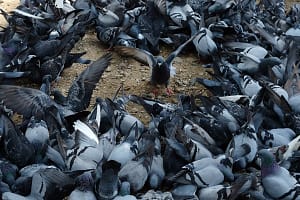While pests are an unwelcome guest in any environment, some businesses deal with these tiny invaders more frequently than others.
In the hectic food sections of restaurants and the clean hallways of hospitals, pests can cause major problems with regard to one’s well-being, financial situation, and reputation.
This article aims to shed light on the top industries affected by pests frequently and explains why these sectors are more susceptible to infestations as well as the popular strategies they tend to employ to prevent them.
By being aware of these challenges, we can recognise the importance of professional pest management and commercial pest control in maintaining clean, pest-free and hazardless environments.
Why pest control is crucial
Keeping an infestation-free workplace is always very important for any business’s reputation, health, and safety.
Numerous issues can arise from pests, such as the transmission of illnesses, contaminating food and surfaces, and even causing structural damage. Common pests that can seriously affect operations include rodents, various insects, and birds that can invade structures and make nests there.
The stakes are higher for those in the food and healthcare industries since pests can pose serious health risks and cause massive financial losses. As a result, implementing efficient pest management strategies is absolutely essential to maintaining operational integrity.
1. Hospitality industry
Businesses from this sector are quite vulnerable to pest infestations due to their high personnel and tourist turnover rates, diverse settings within each institution, and quantity of food sources.
Hotels and resorts
Due to their numerous food sources and heavy foot traffic, hotels and resorts are a popular destination for pests.
Common intruders include rats drawn to food waste, cockroaches, which love warm, humid settings, fleas and bed bugs, which can move swiftly from room to room. Hotels and resorts use strict sanitary standards and routine inspections to fight these pests. By taking preventative measures, pests are found and dealt with before they have a chance to spread, guaranteeing visitors a tidy and comfortable stay.
Restaurants and cafes
Given the nature of food preparation and storage, restaurants and cafés are always vulnerable. Common pests drawn to food spills, crumbs, and incorrectly stored components include flies, cockroaches, ants, and rodents.
Strict waste management procedures, like routinely emptying trash cans and cleaning storage spaces, are necessary for effective pest control at these companies.
Food must also be kept in sealed containers. Maintaining a pest-free dining environment is essential, and this requires routine pest inspections and quick action in the event of an infestation.
2. Food processing and storage
To ensure food safety, both manufacturing and storage facilities, must uphold the strict standards of hygiene and pest management in the food industry they operate in.
Food manufacturing plants
Because food production companies handle large volumes of food and items, they are frequently susceptible to pests.
Moths, beetles, and weevils are just a part of the number of insects that can pose a risk and can quickly infest grain and other stored products, causing significant losses and health hazards.
To prevent infestations, plants frequently employ Integrated Pest Management (IPM) strategies that include a variety of control approaches, including chemical treatments, sanitation, and biological controls.
Tight sanitation rules are important, such as periodically cleaning the equipment and manufacturing places to get rid of any food remnants that might attract pests.
Warehouses and distribution centers
Warehouses and distribution facilities are difficult pest control locations to handle due to their enormous spaces and variable item storage conditions. Rodents and insects may readily enter these regions and hide in cracks and crevices.
To decrease rodent populations, effective pest control measures often include the use of baiting devices, conducting periodic inspections to find and seal entrance points, and maintaining a clutter-free environment to minimise the number of areas where pests may hide.
3. Healthcare facilities
It is fundamental that healthcare facilities, including hospitals, clinics, and nursing homes, protect vulnerable patients from health risks linked to infestations. In this regard, there should never be any exceptions made.
Hospitals and clinics
Hospitals and clinics are especially prone to insect infestations due to the high volume of patients and visitors.
Common pests such as cockroaches, bed bugs, fleas and flies can quickly contaminate sterile environments, transmit dangerous diseases between patients and overall pose serious health risks.
Regular cleaning and disinfection, as well as strict cleaning rules, are a must. Hospitals regularly inspect for pests and take control as needed to prevent infestations and provide a safe environment for patients and staff.
Nursing homes and assisted living
Similarly to the places mentioned above, nursing homes and assisted living facilities are too often endangered or even fighting with an occurring infestation. They, too, require an excellent sanitary atmosphere as well as the ability to process food and medical waste correctly.
Cockroaches, fleas, and bed bugs are common pests that may spread rapidly if not controlled. Proactive pest control practices, such as frequent inspections and good hygiene, are required to keep a healthy and pest-free building. Teaching staff and residents appropriate hygiene habits is an important step in reducing infestations.
4. Education and childcare
Pests thrive in busy places like schools, universities, and daycare centres where there is plenty of food and activity.
Schools and universities
Given their sizable populations and mostly that being kinds and teenagers, with various food sources found in the cafeteria, schools colleges and universities are frequently the target of pests like cockroaches, rats, and ants. Important tactics include teaching staff and students about pest avoidance and how good hygiene and waste disposal practices can mitigate the risk of such event. Infestation risk can be considerably decreased by putting in place regular cleaning schedules and making sure food waste is appropriately controlled and disposed of.
Daycare centers
Because of the young children’s high levels of activity and frequent food spills, daycare centres are particularly vulnerable to pest infestations. The most common pests drawn to sweet spills and leftover food are ants and flies. Maintaining these spaces safe and healthy for kids requires regular cleaning schedules, appropriate trash disposal, and pest-proofing techniques like caulking gaps and adding screens to windows and doors.
5. Retail and commercial spaces
Particularly due to their scale and the range of activities they house, retail spaces, such as malls, shopping centres, and office buildings, present particular pest management issues.
Shopping centres and malls
Food courts and garbage accumulation are the main reasons why bugs and vermin are drawn to shopping centres and malls. Common pests like cockroaches and rodents can spread swiftly if left unchecked.
Regular waste management techniques, such as prompt trash disposal and meticulous cleaning of areas used for food preparation, are essential components of effective pest control strategies.
Frequent inspections guarantee that the necessary steps are followed to keep these busy hubs pest-free and assist spot possible pest problems early.
Office buildings
It can be difficult to keep office buildings pest-free, especially large multi-floor complexes which house thousands of employees. Insects and rodents are effortlessly drawn to food scraps and debris, making it easy for them to enter offices.
In addition to pest control contracts, routine maintenance, such as cleaning and sealing access points, guarantees far less infestation occurrence chances.
6. Agricultural sector
Many pests can pose a threat to crops and livestock, and the agricultural industry is in a a continuous battle with infestations.
Farms and plantations
Pests that can hurt livestock and destroy crops are a constant concern to farms and plantations. Birds, rats, and insects are common pests. Crop rotation, which breaks the life cycles of some pests, pesticides, biological pest control, which uses natural predators, and physical barriers, such fencing, which safeguards crops and cattle, are all effective methods of controlling pests in agriculture.
Greenhouses and nurseries
Because of their often specific conditions, nurseries and greenhouses are very prone to pests such as mites, aphids, and whiteflies. Companies often use Integrated Pest Management (IPM) tactics, which include chemical, biological, and cultural controls.
For instance, aphid populations can also be efficiently and sustainably managed in these areas by using natural predators like ladybirds to control the population, which is very eco-friendly by itself.
Conclusion
In a variety of sectors, like the ones listed here, commercial pest control is always crucial to preserving worker, client and patient’s health and safety and overall, productivity-wise.
Every industry, including hospitality, healthcare, food processing, and agriculture, has different pest management concerns and ways to battle infestations. Businesses may safeguard their surroundings, their customers, and their reputations by putting into practice efficient pest control techniques and maintaining vigilance.
In order to customise the best strategy for pest management and ensure a cleaner, safer, and more productive environment for everyone, it is helpful to understand the unique demands and solutions for each industry and the pest control industries and businesses and what they offer as a response to that.
Be it pest control for healthcare or pest control for retail stores, it’s always good to remember that we should be in control and not the pests.






Leave a Comment